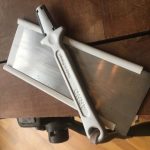We may receive a commission when you use our affiliate links. However, this does not impact our recommendations.

Machining furniture parts on a CNC
In my last post, I covered some of the big issues in learning to use CNCs. Woodworkers first starting to use CNCs in particular benefit from in-person learning because of all the idiosyncrasies that are present when you’re designing and machining wood with a digital tool.
There are a number of good solutions for learning more about these tools. Some are available in your local community. Here are some suggestions on training or other ways to learn more about digital woodworking.
Woodworking Guilds
The first place to look for help might be within your local community. Perhaps there’s a woodworker’s guild in your area. If so, it’s likely that either the group or someone within it already has a CNC and might be willing to give you a demonstration or a tutorial on how it works. Even better, you could ask them to guide you through a few projects so you can learn more about the process.
Woodworking Stores
If you live close to a dedicated woodworking store, there’s a good chance that they have a CNC. I’ve seen them at every woodworking store I’ve been to in the last few years. If they have one, ask to see if they have any classes on how to use them. You don’t have to own one to take a class to learn about them. Often they’ll run the demos that come with the machines. But ask them to show you more than the usual fancy demo carving a 3D sign. Ask them to show you practical uses such as how to cut parts and set up the CNC for running a project.

Making clamping fixtures to hold furniture parts on a CNC
CNC User Groups
Another great way to learn is through community organizations called user groups. User groups are a lot like woodworking guilds. These are groups of people focused on a particular topic. Except, user groups are typically focused on technology in one form or another. Though CNCs are something of a specialty machine, they are popular with all kinds of craftspeople and makers. That’s producing a broader group of users who share your interest. As a result, CNC user groups are starting to show up in many communities.
Even if the group is not specifically focused on woodworking, you can learn a lot from others who may have more experience and different uses for the tools. The key is you’re not alone when you’re in a user group. Everyone is there to learn. Just at different phases.
Learning and sharing are what user groups are all about. That makes them a great place to learn about new digital tools. I’ve been very involved with user groups since the mid-80’s. I can tell you from experience that when people get together and share what they know, user groups really do work. I highly recommend them.
If there’s not a user group in your area, start one. Put the word out. You’ll be surprised at how many people have the same interest and desire to learn as you.
Maker Spaces
People all over the world that are passionate about creating with their hands and minds have grown an idea into what is referred to as the Maker Movement. To support a common interest in building things, community workspaces are popping up so that people can share tools, experience and a place to work. The are particularly popular in bigger cities.
They’re usually run like clubs. It’s common that these groups have digital tools like CNC routers, laser cutters, 3D printers and often complete woodshops, as well. Typically run by knowledgeable members, these maker spaces are excellent places to get access to the tools and learn how to get the most out of them. Woodworkers usually work in solid wood, while makers more often use plywood – a material that you definitely want to know how to machine. And much of what you can learn in a maker space can be applied to digital woodworking on your own projects.
Adult Education
Dedicated classes are also a desirable option. Possibly, community colleges with adult evening or weekend classes might have a class focused on learning running CNCs or laser cutters for hobbyists, craftsmen and artists. They’re also a likely place to learn the CAD design software that you’ll be using to create the drawings that you’ll need to run CNCs.
Specialty adult education focused on new technology for hobbyists, not just students on a professional career path is an area ripe for development by trade schools, vocational schools and community colleges. They should consider offering classes for hobbyists who also need to learn how to use these tools safely and productively. The already have the teaching skills, facilities and equipment. Slimmed down classes for hobbyists that are hungry to learn only makes sense. A few evening classes are all it takes. Opportunity is knocking.

Making precise cuts on an angled table leg
Digital Woodworking Classes
Finally, there are a few dedicated classes focused on teaching woodworkers how to use digital tools. I’ve seen them show up in different parts of the country at a few woodworking schools but the school I’m most familiar with is the Marc Adams School of Woodworking in Indiana. Like a number of Popular Woodworking contributors, I’ve taught there for several years. Last year the school started a digital woodworking program to help woodworkers learn how to use these new tools and develop new ways to combine them with existing woodworking skills, tools and techniques.
In 2017 I’ll be teaching two classes in the spring. The first is a weekend introductory class into the world of digital woodworking, followed by a five-day hands-on class where we’ll use digital tools on a furniture project. In the fall, I’ll teach a CNC woodworking skills and techniques class for those a little more familiar with the tools. Think of it as a beyond-the-basics hand tool skills class for woodworkers who plan on adding digital tools to their shop and want to use them regularly in their projects and work. And, just for fun, there’s a weekend class where we’ll make all kinds of holiday gifts using CNCs, laser cutters and all the other woodworking tools in the shop. Digital woodworking experience not required.
Photos courtesy of Mark Sterner
Here are some supplies and tools we find essential in our everyday work around the shop. We may receive a commission from sales referred by our links; however, we have carefully selected these products for their usefulness and quality.








